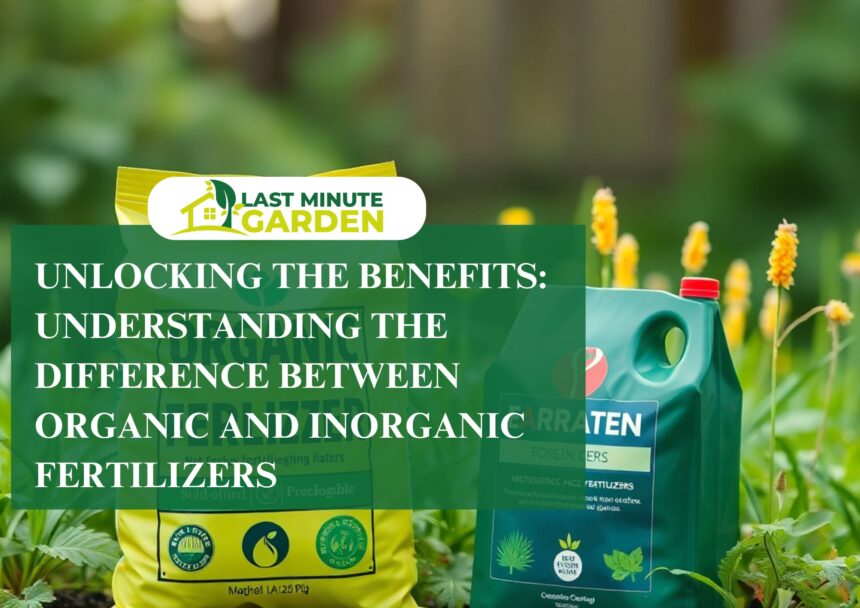Understanding the difference between organic and inorganic fertilizers is crucial for maintaining soil health and promoting plant growth.
Organic and inorganic fertilizers serve distinct purposes, each providing specific nutrients essential for plants.
This article will explore the definitions, differences, benefits, and considerations surrounding these two types of fertilizers, enabling gardeners and farmers to make informed decisions based on their soil needs and environmental impacts.

What Are Organic and Inorganic Fertilizers?
What is an Organic Fertilizer?
Organic fertilizers are derived from natural sources, such as manure, compost, and plant materials. These fertilizers contain various nutrients that are essential for plant growth, including nitrogen, phosphorus, and potassium, often referred to as NPK.
Organic fertilizers are rich in organic matter, which improves soil structure and fertility. Additionally, they release nutrients slowly, allowing for a steady supply that supports healthy plant development.
By enhancing the microbial activity in the soil, organic fertilizers contribute to a balanced ecosystem that benefits both plants and soil health.
Organic fertilizers not only provide essential macronutrients but also improve soil fertility over time. The slow nutrient release characteristic of organic fertilizers allows plants to absorb nutrients at their own pace, reducing the risk of nutrient leaching and ensuring that vital elements remain available in the soil.
This natural process fosters a thriving environment for beneficial microorganisms, which further aids in nutrient cycling.
Furthermore, organic fertilizers are often more sustainable, aligning with principles of organic farming and environmental stewardship.
What is an Inorganic Fertilizer?
In contrast, inorganic fertilizers, also known as synthetic fertilizers, are manufactured from chemical processes and contain concentrated nutrients.
These fertilizers typically provide specific ratios of nitrogen, phosphorus, and potassium (NPK) in a form that is quickly available to plants.
Inorganic fertilizers can also include micronutrients that are crucial for plant health. Due to their chemical composition, these fertilizers tend to be more potent and can rapidly enhance soil fertility, resulting in immediate plant growth benefits.
Inorganic fertilizers are often perceived as efficient due to their quick nutrient-release capabilities. They are designed to deliver precise amounts of essential nutrients directly to plants, making them popular among farmers and gardeners seeking immediate results.
However, reliance on inorganic fertilizers can lead to concerns regarding soil health and long-term sustainability, as they may disrupt the natural balance of soil microorganisms and contribute to nutrient leaching.
Understanding the implications of using synthetic fertilizers is vital for maintaining a healthy growing environment.
What is the Difference Between Organic and Inorganic Fertilizers?

How Do Nutrients Differ in Organic vs Inorganic?
The primary difference between organic and inorganic fertilizers lies in their nutrient composition and release mechanisms.
Organic fertilizers tend to contain a broader range of nutrients, including essential macronutrients and micronutrients, in a form that is slowly available to plants. This gradual release supports prolonged plant growth and minimizes the risk of nutrient leaching into waterways.
In contrast, inorganic fertilizers typically provide concentrated amounts of specific nutrients, which are readily available for uptake by plants. While this can lead to rapid growth, it may also result in nutrient imbalances and potential environmental harm.
Moreover, organic fertilizers often include beneficial microorganisms that enhance soil health, promoting a thriving ecosystem of soil life.
Inorganic fertilizers, while effective in delivering immediate nutrients, do not contribute to the organic matter in the soil and may disrupt the natural balance of soil microorganisms.
The differences between organic and inorganic fertilizers are significant, as they dictate the long-term health of both plants and the soil environment. This understanding is crucial for gardeners and farmers who aim to cultivate sustainable and productive growing practices.
What Are the Differences in Composition?
When comparing the composition of organic and inorganic fertilizers, the contrasts are stark. Organic fertilizers are composed of natural materials like plant residues, animal manure, and compost, offering a diverse array of nutrients that contribute to soil fertility.
These fertilizers often contain trace elements, organic acids, and other beneficial compounds that improve soil structure and microbial activity.
In contrast, inorganic fertilizers are predominantly made from chemical compounds that provide a specific ratio of primary nutrients—nitrogen, phosphorus, and potassium (NPK)—in concentrated forms, such as ammonium nitrate or superphosphate.
This difference in composition impacts their application and effectiveness in supporting plant growth.
Organic fertilizers not only supply essential nutrients but also enhance the soil’s organic matter, leading to improved water retention, aeration, and microbial diversity.
Inorganic fertilizers, while efficient in providing immediate nutrient access, can lead to soil degradation and reduced microbial populations over time.
Understanding these differences in composition helps gardeners choose the right type of fertilizer based on their specific soil needs and long-term agricultural goals.
How Do They Affect Soil Health?
The impact of organic and inorganic fertilizers on soil health is another critical area of comparison. Organic fertilizers contribute positively to soil health by increasing organic matter content, which enhances soil structure and facilitates better water retention.
The presence of organic matter supports a thriving community of microorganisms that play vital roles in nutrient cycling and soil fertility.
This microbial activity helps break down organic materials, releasing nutrients in a manner that is accessible to plants while improving soil aeration and drainage.
What Are the Benefits of Using Organic Fertilizers?

How Do Organic Fertilizers Improve Soil Fertility?
Organic fertilizers play a significant role in improving soil fertility through their ability to enhance the organic matter content of the soil.
As these fertilizers decompose, they release essential nutrients like nitrogen, phosphorus, and potassium, which are crucial for plant growth.
This slow-release mechanism ensures that plants have a consistent supply of nutrients, fostering healthy growth and development.
Moreover, the organic matter contributes to improved soil structure, enhancing its capacity to retain moisture and nutrients, thus benefiting plant roots.
The incorporation of organic fertilizers also increases the microbial activity in the soil, which is vital for nutrient cycling. Beneficial microorganisms break down organic materials, releasing nutrients that are easily accessible to plants.
This process not only boosts soil fertility but also supports the overall health of the soil ecosystem. By using organic fertilizers, gardeners and farmers can create a sustainable growing environment that promotes long-term soil health and productivity, ultimately leading to healthier crops and more resilient agricultural systems.
What Role Does Organic Matter Play?
Organic matter plays a fundamental role in soil health and fertility, acting as a reservoir for nutrients and moisture.
Organic fertilizers, which are rich in organic materials, contribute to the accumulation of organic matter in the soil, enhancing its overall quality. This organic matter improves soil structure, allowing for better aeration and drainage, which are essential for healthy root development.
Additionally, organic matter serves as a source of food for beneficial microorganisms, promoting a diverse soil ecosystem that supports plant growth.
Furthermore, organic matter helps to buffer soil pH, reducing the impact of extreme acidity or alkalinity on plant health. It also plays a crucial role in nutrient retention, preventing leaching and ensuring that essential nutrients remain available for plant uptake.
The presence of organic matter in the soil not only contributes to improved fertility but also enhances its resilience against erosion and degradation.
By recognizing the importance of organic matter, gardeners can better appreciate the benefits of using organic fertilizers in their cultivation practices.
What Are the Advantages of Inorganic Fertilizers?

How Quickly Do Inorganic Fertilizers Release Nutrients?
One of the primary advantages of inorganic fertilizers is their rapid nutrient-release capability. These fertilizers contain concentrated forms of essential nutrients, such as nitrogen, phosphorus, and potassium, allowing for quick absorption by plants.
This immediacy can be particularly beneficial in situations where plants require a fast nutrient boost, such as during critical growth phases or when facing nutrient deficiencies.
The quick nutrient availability provided by inorganic fertilizers can lead to noticeable improvements in plant growth and vigor.
However, this rapid nutrient release can also pose challenges, such as the risk of nutrient leaching into water sources, which can lead to environmental issues.
Despite this concern, the efficiency of inorganic fertilizers in delivering immediate nutrients cannot be overlooked, especially in commercial agriculture where maximizing crop yields is a priority.
Understanding the timing and application methods of inorganic fertilizers is essential for optimizing their benefits while mitigating potential negative impacts on the environment.
How Do Organic and Inorganic Fertilizers Affect Plant Growth?

Which Fertilizer Type Provides Better Nutrient Balance?
When it comes to providing a balanced nutrient supply, organic fertilizers often outperform their inorganic counterparts. Organic fertilizers release nutrients gradually, allowing plants to absorb them at a steady pace, which aligns with their growth requirements.
This slow-release mechanism helps prevent nutrient imbalances that can occur with rapid nutrient influx from inorganic fertilizers.
Additionally, the diverse nutrient profile of organic fertilizers supports overall plant health, ensuring that all essential macronutrients and micronutrients are available throughout the growing season.
Inorganic fertilizers, while effective in delivering concentrated nutrients quickly, can lead to nutrient surges that may stress plants or result in imbalances.
For instance, excessive nitrogen from synthetic fertilizers can promote lush foliage at the expense of root and fruit development.
Therefore, while inorganic fertilizers can provide immediate benefits, the balanced approach of organic fertilizers contributes to healthier, more resilient plants in the long term.
Recognizing the importance of nutrient balance is crucial for gardeners and farmers aiming to optimize plant growth and yield.
Can You Use Organic and Inorganic Fertilizers Together?

What is the Best Approach for Gardeners?
Combining organic and inorganic fertilizers can be an effective strategy for gardeners seeking to optimize plant growth while maintaining soil health.
A balanced approach allows for the immediate nutrient availability provided by inorganic fertilizers while benefiting from the long-term soil improvements associated with organic fertilizers.
By using both types of fertilizers, gardeners can tailor their nutrient applications based on specific plant needs and soil conditions, ultimately achieving a more sustainable and productive growing environment.
For instance, applying inorganic fertilizers during critical growth phases can provide plants with the necessary nutrients to thrive, while organic fertilizers can be used to improve soil structure and microbial activity over time.
This synergistic approach can lead to enhanced plant health, increased yields, and improved soil fertility.
However, careful monitoring of nutrient levels and plant responses is crucial to avoid potential nutrient imbalances that could arise from combining both fertilizer types.
How Does Combining Fertilizers Affect Plant Health?
The combination of organic and inorganic fertilizers can positively influence plant health by ensuring a well-rounded nutrient supply.
This integrated approach allows for the rapid nutrient uptake characteristics of inorganic fertilizers while simultaneously enhancing soil organic matter through organic fertilizers.
The result is a more balanced feeding regime that supports robust plant growth, improved fruit and flower development, and overall vitality.
As both fertilizer types work together, they can create an environment conducive to healthy root systems and sturdy plant structures.
However, it is essential to monitor the application rates and timing carefully to prevent potential nutrient overload or imbalances.
An integrated fertilizer approach can help mitigate the risks associated with over-reliance on either type and ensure that plants receive the nutrients they need without compromising soil health.
Ultimately, combining organic and inorganic fertilizers in a thoughtful manner can lead to thriving plants and sustainable gardening practices.
Conclusion

Choosing between organic and inorganic fertilizers depends on your gardening goals, soil condition, and long-term sustainability plans.
Organic fertilizers enrich the soil naturally, promoting microbial activity and improving soil health over time. They are an excellent choice for gardeners and farmers looking for a sustainable, eco-friendly approach to plant nutrition.
On the other hand, inorganic fertilizers provide an immediate nutrient boost, ensuring rapid plant growth and higher yields, making them ideal for short-term agricultural needs.
For many growers, a balanced approach—combining the immediate benefits of inorganic fertilizers with the long-term soil improvements of organic fertilizers—can be the best strategy.
Ultimately, understanding the differences between these fertilizers helps you make informed choices that support both plant health and environmental sustainability.
Whether you are an organic farming advocate or prefer synthetic fertilizers for their efficiency, the key is to apply them wisely, ensuring that your soil remains healthy and productive for years to come.





